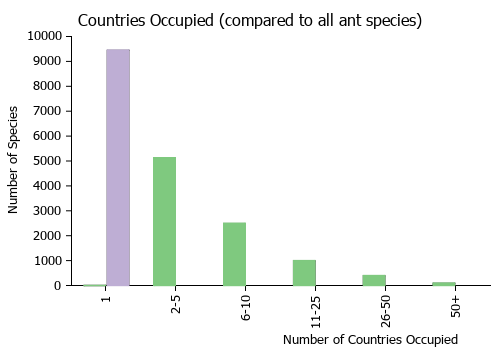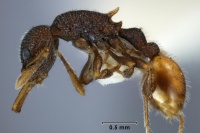Epopostruma angela
| Epopostruma angela | |
|---|---|

| |
| Scientific classification | |
| Kingdom: | Animalia |
| Phylum: | Arthropoda |
| Class: | Insecta |
| Order: | Hymenoptera |
| Family: | Formicidae |
| Subfamily: | Myrmicinae |
| Tribe: | Attini |
| Genus: | Epopostruma |
| Species: | E. angela |
| Binomial name | |
| Epopostruma angela Shattuck, 2000 | |
This rare species is known from only a handful of collections, one consisting of a nest in dry leaf litter in a medium sclerophyll woodland.
Identification
Posterior section of metanotum in approximately the same plane as the dorsal face of propodeum so that the junction of these plates is either indistinct or in the form of a shallow trough or depression. Sides of postpetiole vertical medially (not expanded laterally), with blunt angles anteriorly and the posterior corners drawn lateral into broadly rounded spines or teeth, in dorsal view outer margins concave. Dorsum of petiole, postpetiole and gaster with numerous erect hairs.
Keys including this Species
Distribution
Latitudinal Distribution Pattern
Latitudinal Range: -27.39999962° to -35.68333054°.
| North Temperate |
North Subtropical |
Tropical | South Subtropical |
South Temperate |
- Source: AntMaps
Distribution based on Regional Taxon Lists
Australasian Region: Australia (type locality).
Distribution based on AntMaps
Distribution based on AntWeb specimens
Check data from AntWeb
Countries Occupied
| Number of countries occupied by this species based on AntWiki Regional Taxon Lists. In general, fewer countries occupied indicates a narrower range, while more countries indicates a more widespread species. |

|
Estimated Abundance
| Relative abundance based on number of AntMaps records per species (this species within the purple bar). Fewer records (to the left) indicates a less abundant/encountered species while more records (to the right) indicates more abundant/encountered species. |

|
Biology
|
Castes
Nomenclature
The following information is derived from Barry Bolton's Online Catalogue of the Ants of the World.
- angela. Epopostruma angela Shattuck, in Bolton, 2000: 57, figs. 58, 72, 87 (w.) AUSTRALIA.
Type Material
- Holotype, worker, vic. Jollys Lookout, Nebo-Brisbane Road, Queensland, Australia, Taylor,R.W., ANIC32-003667, Australian National Insect Collection.
- Paratype, 3 workers, vic. Jollys Lookout, Nebo-Brisbane Road, Queensland, Australia, Taylor,R.W., ANIC32-003667, Australian National Insect Collection.
Unless otherwise noted the text for the remainder of this section is reported from the publication that includes the original description.
The northern specimens of this species are slightly larger and darker than the single specimen known from southern New South Wales but are otherwise similar. Given the limited amount of presently available material it is difficult to assess the significance of these differences and all specimens are tentatively assumed to represent a single slightly variable species.
Description
In full face view the lateral margin of the head between the eye and the posterior corner angular. Pronotal spines distinct. Posterior section of metanotum in approximately the same plane as the dorsal face of propodeum so that the junction of these plates is either indistinct or in the form of a shallow trough or depression. Posterior face of propodeum between bases of spines and propodeal lobes with flanges. Petiolar spines present, distinct. Anterior face of postpetiole approximately the same length as the dorsal face, the two faces separated by a broad, rounded angle; sides of postpetiole vertical medially (not expanded laterally), with blunt angles anteriorly and the posterior corners drawn lateral into broadly rounded spines or teeth, in dorsal view outer margins concave; posterolateral margin of postpetiole (immediately anterior of gaster) weakly concave. Dorsum of petiole, postpetiole and gaster with numerous erect hairs. First gastral tergite smooth, the area immediately behind attachment with gaster with short, longitudinal rugae. Body colour dark red-brown, appendages slightly lighter; dorsal surface of head uniform dark red-brown; gaster yellow-red, sometimes the posterior region of first tergite with an ill-defined infuscated band.
Measurements
Holotype worker. TL 3.9mm, HL 0.87mm, HW 0.84mm, CI 97, MandL 0.49mm, MandI 56, SL 0.53mm, SI 63, PronW 0.55mm, ML 1.01mm.
References
- Shattuck, S. O. 2000. Genus Colobostruma. Genus Mesostruma. Genus Epopostruma. Pp. 31-67 in: Bolton, B. The ant tribe Dacetini. Mem. Am. Entomol. Inst. 65: 1-1028 (page 57, worker described)


